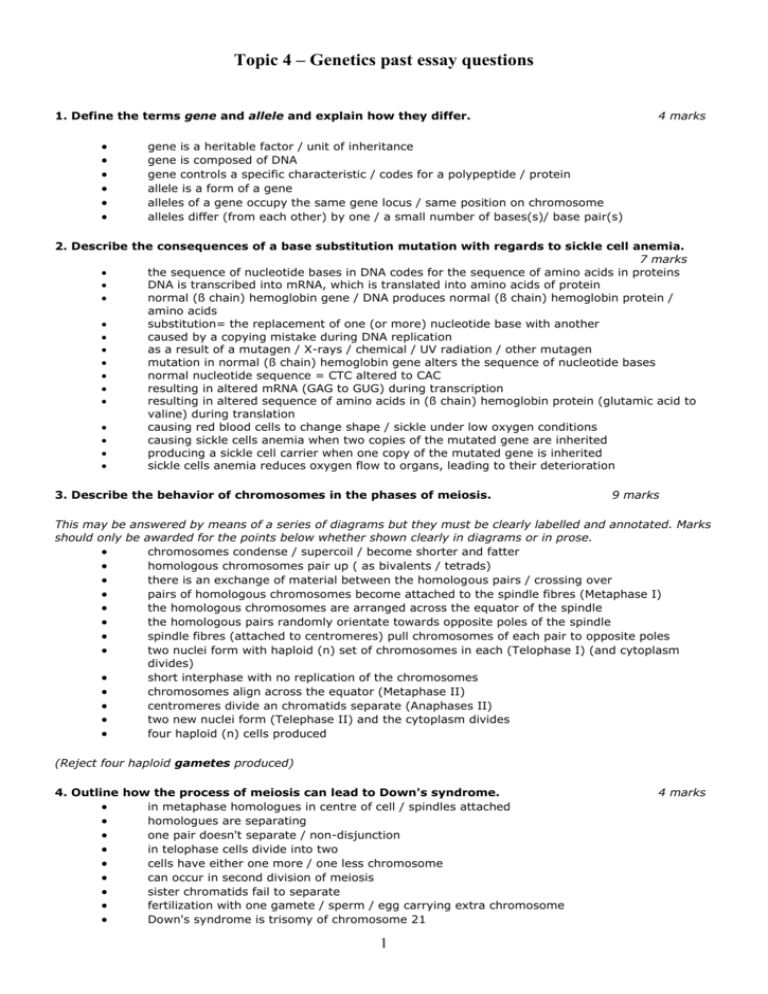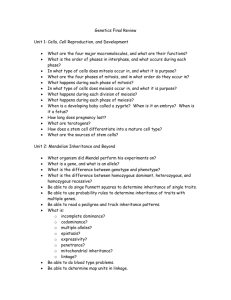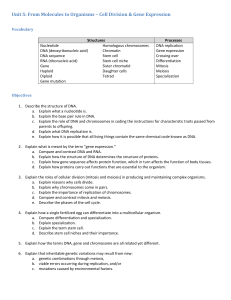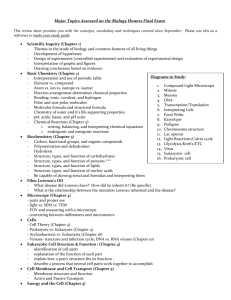Topic 4 Genetics essay qus
advertisement

Topic 4 – Genetics past essay questions 1. Define the terms gene and allele and explain how they differ. 4 marks gene is a heritable factor / unit of inheritance gene is composed of DNA gene controls a specific characteristic / codes for a polypeptide / protein allele is a form of a gene alleles of a gene occupy the same gene locus / same position on chromosome alleles differ (from each other) by one / a small number of bases(s)/ base pair(s) 2. Describe the consequences of a base substitution mutation with regards to sickle cell anemia. 7 marks the sequence of nucleotide bases in DNA codes for the sequence of amino acids in proteins DNA is transcribed into mRNA, which is translated into amino acids of protein normal (ß chain) hemoglobin gene / DNA produces normal (ß chain) hemoglobin protein / amino acids substitution= the replacement of one (or more) nucleotide base with another caused by a copying mistake during DNA replication as a result of a mutagen / X-rays / chemical / UV radiation / other mutagen mutation in normal (ß chain) hemoglobin gene alters the sequence of nucleotide bases normal nucleotide sequence = CTC altered to CAC resulting in altered mRNA (GAG to GUG) during transcription resulting in altered sequence of amino acids in (ß chain) hemoglobin protein (glutamic acid to valine) during translation causing red blood cells to change shape / sickle under low oxygen conditions causing sickle cells anemia when two copies of the mutated gene are inherited producing a sickle cell carrier when one copy of the mutated gene is inherited sickle cells anemia reduces oxygen flow to organs, leading to their deterioration 3. Describe the behavior of chromosomes in the phases of meiosis. 9 marks This may be answered by means of a series of diagrams but they must be clearly labelled and annotated. Marks should only be awarded for the points below whether shown clearly in diagrams or in prose. chromosomes condense / supercoil / become shorter and fatter homologous chromosomes pair up ( as bivalents / tetrads) there is an exchange of material between the homologous pairs / crossing over pairs of homologous chromosomes become attached to the spindle fibres (Metaphase I) the homologous chromosomes are arranged across the equator of the spindle the homologous pairs randomly orientate towards opposite poles of the spindle spindle fibres (attached to centromeres) pull chromosomes of each pair to opposite poles two nuclei form with haploid (n) set of chromosomes in each (Telophase I) (and cytoplasm divides) short interphase with no replication of the chromosomes chromosomes align across the equator (Metaphase II) centromeres divide an chromatids separate (Anaphases II) two new nuclei form (Telephase II) and the cytoplasm divides four haploid (n) cells produced (Reject four haploid gametes produced) 4. Outline how the process of meiosis can lead to Down's syndrome. in metaphase homologues in centre of cell / spindles attached homologues are separating one pair doesn't separate / non-disjunction in telophase cells divide into two cells have either one more / one less chromosome can occur in second division of meiosis sister chromatids fail to separate fertilization with one gamete / sperm / egg carrying extra chromosome Down's syndrome is trisomy of chromosome 21 1 4 marks 5. Compare the processes of mitosis and meiosis. 6 marks answers must be pair-wise comparisons to receive any marks. Mitosis: one cell division & Meiosis: two divisions / reduction division Mitosis: chromosome number does not change & Meiosis: converts diploid to haploid cells Mitosis: products genetically identical & Meiosis: products genetically diverse Mitosis: separation of sister chromatids in anaphase & Meiosis: separation of homologous chromosomes in anaphase I and sister chromatids in anaphase II Mitosis: no crossing over & Meiosis: crossing over in prophase I Mitosis: no formation of tetrads / no synapsis & Meiosis: formation of tetrads / synapsis Mitosis: produce cells for growth/repair/asexual reproduction & Meiosis: produce sexual cells / gametes for sexual reproduction Mitosis: two cells produced & Meiosis: four cells produced Mitosis: daughter cells with both copies of chromosomes/random assortment does not occur & Meiosis: random assortment of maternal/ paternal chromosomes Mitosis: replication of DNA in interphase & Meiosis: replication of DNA in interphase I Mitosis: four phases: prophase, metaphase, anaphase, telophase & Meiosis: same four phases twice 6. Outline one example of inheritance involving multiple alleles. 5 marks multiple alleles means a gene has three or more alleles / more than two alleles ABO blood groups / other named example of multiple alleles ABO gene has three alleles / equivalent for other example IA IB and i shown (at some point in the answer) / equivalent for other example accept other notation for alleles if clear any two of these alleles are present in an individual homozygous and heterozygous genotype with phenotypes (shown somewhere) all six genotypes with phenotypes given (shown somewhere) example / diagram of a cross involving all three alleles 7. Describe the inheritance of ABO blood groups including an example of the possible outcomes of a homozygous blood group A mother having a child with a blood group O father. 5 marks example of co-dominance multiple alleles / 3 alleles (phenotype) O has (genotype) ii B can be IB IB or IB i A can be IA IA or IA i AB is IA IB (P are) i i x IA IA (gametes) i and IA (F1 genotype) IA i (F1 phenotype) blood group A 8. Outline sex linkage. 5 marks gene carried on sex chromosome / X chromosome / Y chromosome inheritance different in males than in females males have only one X chromosome therefore, only one copy of the gene mutation on Y chromosome can only be inherited by males women can be carriers if only one X chromosome affected example of sex linked characteristics (e.g. hemophilia / color blindness) example of cross involving linkage 2 9. Explain, using a named example, why many sex-linked diseases occur more frequently in men than women. 9 marks named example of sex-linked disease caused by recessive allele on the X chromosome example of pair of alleles (e.g. X H and X h) (reject if alleles do not correspond) females are XX and males are XY females have two alleles of the gene and males have only one allele causing the disease is rare / uncommon probability of females inheriting rare allele twice as low calculation of squaring the gene frequency female would have to inherit the allele from her father who would have suffered from the disease so females can carry the gene but still be normal but males (with the gene) will have the disease 10. Outline the process of DNA profiling (genetic fingerprinting), including ways in which it can be used. 6 marks sample of DNA obtained / leucocytes / from mouthwash / hair / other named source satellite DNA / repetitive sequences used for profiling amplification of DNA by polymerase chain reaction / PCR cutting DNA into fragments using restriction enzymes separation of fragments of DNA (by electrophoresis) separation according to the length of the fragments pattern of bands obtained / different pattern of bands with DNA from different individuals used for criminal investigations / example of use in criminal investigation used to check paternity / who is the father / mother / parent used to check whether two organisms are clones 11. Outline DNA profiling (genetic fingerprinting), including one way in which it has been used. 5 marks DNA profiling: 4 max sample of DNA / blood / saliva / semen is obtained reference samples of DNA are obtained PCR used to amplify / produce more copies of the DNA DNA broken into fragments by restriction enzymes DNA fragments are separated by gel electrophoresis DNA separated into a series of bands bands compared between different samples if pattern of bands is the same then DNA is (almost certainly) from same source if some bands are similar then individuals are (almost certainly) related specific example: 1 max testing of paternity / forensics / classification / archeology / another specific example 12. Outline a technique for transferring genes between species. gene of interest is cut out with restriction enzyme RNA used to produce DNA using reverse transcriptase plasmid cut open with same restriction enzyme gene inserted into plasmid blunt ends / sticky ends spliced together by DNA ligase recombinant plasmids are cloned / many copies produced recombinant plasmids are inserted into new host cells / virus / bacteriophage / yeast inserted by shooting / spraying / microencapsulation / by heat treatment 3 5 marks 13. Describe the technique for the transfer of the insulin gene using E. coli. 6 marks mRNA is extracted DNA copy of RNA is made using reverse transcriptase plasmids are cut open with endonucleases (at specific sequences) insulin gene and plasmid are mixed together addition of 'sticky ends' to the DNA copy (so that it will combine with the cut plasmid) DNA ligase will seal the plasmid recombinant plasmid is inserted into E. coli E. coli is cultured E. coli begins to make insulin 14. Discuss the potential benefits and possible harmful effects of genetic modification. 7 marks named example of desired outcome e.g. herbicide resistance Award 6 max if no named example given. Award 5 max if both possible benefits and possible harmful effects are not addressed. Possible benefits: 4 max benefits include more specific (less random) breeding than with traditional methods faster than traditional methods some characteristics from other species are unlikely in the gene pool / selective breeding cannot produce desired phenotype increased productivity of food production / less land required for production less use of chemical (e.g. pesticides) food production possible in extreme conditions less expensive drug preparation e.g. pharmaceuticals in milk human insulin engineered so no allergic reactions may cure genetic diseases Possible harmful effects: 4 max some gene transfers are regarded as potentially harmful to organism (especially animals) release of genetically engineered organisms in the environment can spread and compete with the naturally occurring varieties some of the engineered genes could also cross species barriers technological solution when less invasive methods may bring similar benefits reduces genetic variation / biodiversity 15. Discuss the ethical arguments for and against the cloning of humans. 4 marks arguments against cloning: 3 max reduces the value / dignity of the individual / causes psychological problems high miscarriage rates / cloned individuals are likely to have developmental disorders / health problems / cloned individuals may show premature aging costly process and money could be better spent on other types of healthcare cloning may be done for inappropriate motives / replace lost loved one / perfect race etc. arguments for cloning: 3 max identical twins are formed by cloning so it is a natural process cloned embryos can be tested for genetic disease / genetic screening increased chance of children for infertile couples cloning research may lead to spin-offs for other research areas such as cancer / transplant research / regeneration research 4 16. Outline the ethical issues of cloning humans. 6 marks clones are genetically identical individuals / cell lines / tissues risks to society cloning mammals is expensive / allocation of resources cloning could lead to copying selected individuals / equity concerns could lead to uncontrolled / unethical eugenics risks to individuals many cloned animals die soon after birth / die for complications / premature aging of clones cloned humans could experience identity crises / problems in psychological development reduction of human dignity cloned tissues will still possess genetic diseases risk for unknown consequences too great belief systems artificial cloning in humans is opposed by some as being unnatural / against their religion cloning occurs naturally when identical twins form cloning humans may help to provide tissues / organs for transplantation research in cellular mechanisms / developmental biology / possible medical breakthroughs benefits 5









